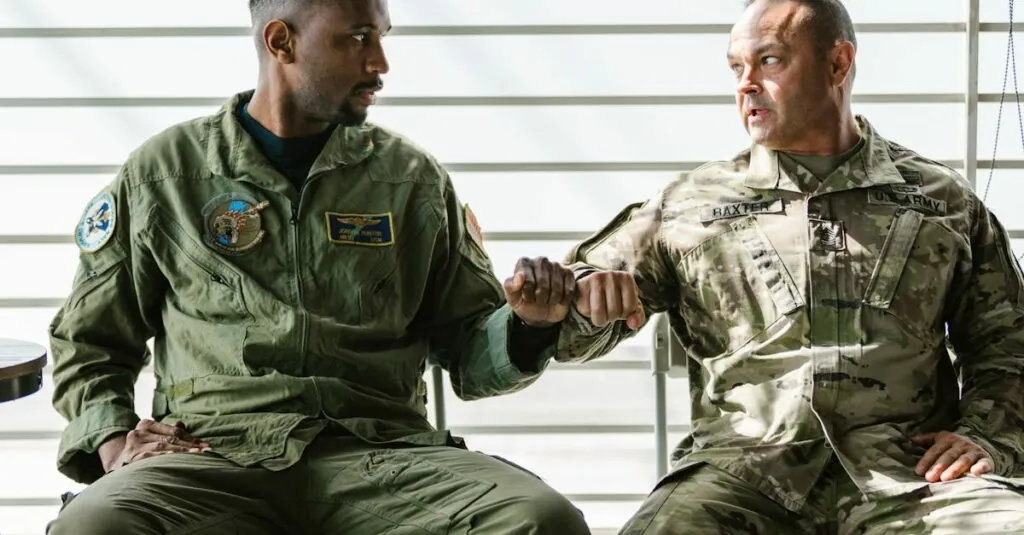Table of Contents
ToggleIn a world where alliances can make or break a nation’s security, understanding defense alliance status is more crucial than ever. Picture this: nations huddled together like a group of friends at a middle school dance, trying to figure out who’s got each other’s backs. It’s a delicate balance of trust, strategy, and a dash of diplomacy.
As global threats evolve, so do the partnerships that keep countries safe. Whether it’s a handshake deal or a full-blown treaty, these alliances shape the geopolitical landscape. So, why should anyone care? Because knowing the status of these alliances can be the difference between peace and chaos. Buckle up as we dive into the intricate world of defense alliances and discover why they matter now more than ever.
Overview of Defense Alliances
Defense alliances represent crucial partnerships among nations committed to mutual security. These alliances often manifest through formal treaties or informal agreements, promoting collaboration against common threats. NATO, for instance, showcases a significant defense alliance comprising 31 member nations, highlighting collective security principles.
Security arrangements vary widely depending on regional dynamics and political objectives. In the Asia-Pacific region, security pacts like AUKUS involve Australia, the United Kingdom, and the United States, aiming to strengthen military capabilities in response to rising tensions. Similarly, the bilateral security agreement between Japan and the U.S. emphasizes Japan’s defense initiatives while ensuring American military support.
Global awareness of these alliances is vital, as they influence diplomatic relations and military strategies. Nations that form alliances often enhance their deterrence capabilities, reducing the likelihood of aggression from potential adversaries. The interconnectedness of defense alliances stems from shared values, geopolitical interests, and strategic objectives, fostering stability in volatile areas.
Military exercises among allied nations serve to enhance interoperability and build trust. These exercises often prepare forces for real-world scenarios while reinforcing commitment to collective defense. By coordinating strategies and sharing intelligence, allied nations can react effectively to emerging threats.
Understanding the complexities of defense alliances helps to navigate the intricate web of international relations. Awareness of these partnerships supports informed decision-making in global security matters.
Current Defense Alliance Status
Defense alliances play a pivotal role in shaping global security dynamics. Their structures evolve according to emerging threats and diplomatic relations.
Major Global Alliances
NATO remains a cornerstone of collective security arrangements, uniting 31 nations. Member states commit to mutual defense and share intelligence, contributing to regional stability. The alliance addresses modern challenges, including cybersecurity and terrorism. The Quad, composed of the US, India, Japan, and Australia, promotes security cooperation in the Indo-Pacific, emphasizing maritime security. Lastly, the Shanghai Cooperation Organization facilitates collaboration among its eight member nations, focusing on counter-terrorism and economic cooperation.
Regional Alliances
AUKUS enhances defense ties between Australia, the UK, and the US. This pact strengthens military capabilities through sharing advanced technology, notably in nuclear submarines. In Europe, the European Union’s Common Security and Defence Policy fosters closer military cooperation among member states. The US-Japan Security Alliance exemplifies a bilateral effort, ensuring mutual defense and establishing military presence in the region. ASEAN also cultivates partnerships among Southeast Asian nations, addressing non-traditional security threats and promoting stability.
Factors Influencing Defense Alliance Status
Several factors influence the status of defense alliances, shaping their formation and resilience in a shifting global landscape.
Political Considerations
Political dynamics play a critical role in defense alliances. Changes in government, public opinion, or leadership styles can cause shifts in foreign policy alignment. Nations reassess treaties when new threats emerge or when strategic interests diverge. Increased cooperation often results from shared democratic values and common security concerns. Regional stability enhances these alliances, as peaceful relationships between nations foster stronger military collaborations. Additionally, alliances may adjust in response to geopolitical tensions, like the rise of authoritarian powers that challenge existing norms.
Economic Impacts
Economic factors considerably affect defense alliance status. Resource allocation for military spending relies on national economies, influencing the willingness of countries to invest in joint defense efforts. Economic partnerships enhance military cooperation as nations share technological advancements and investment opportunities. Trade agreements can also underpin these alliances, supporting stability through interdependence. Economic sanctions against adversaries may strengthen alliances as member states unite to counter common threats. Consequently, a nation’s economic health directly impacts its defense strategy and willingness to engage in collective security frameworks.
Case Studies of Notable Alliances
Defense alliances serve as crucial frameworks for international security. Through various historical examples, these partnerships highlight the dynamics of geopolitical cooperation.
NATO
NATO stands as a pivotal alliance established in 1949, promoting collective defense among its 31 member nations. Security guarantees operate under Article 5, which asserts that an attack on one member constitutes an attack on all. This principle strengthens deterrence against potential aggressors. The organization addresses contemporary issues, such as cybersecurity threats and terrorism. Intelligence sharing among members further enhances regional stability. Regular military exercises, like “Defender Europe,” improve interoperability and readiness of forces involved. NATO’s expansion efforts include partnerships with countries like Sweden and Finland, adapting to evolving security landscapes.
ASEAN
ASEAN, formed in 1967, represents a significant regional alliance in Southeast Asia, emphasizing economic cooperation and political stability. The organization incorporates ten member countries, promoting peace and security through dialogue and diplomacy. Through the Treaty of Amity and Cooperation, ASEAN fosters mutual respect and non-interference among nations. Collaborative efforts extend to addressing transnational issues, such as terrorism and natural disasters. The ASEAN Regional Forum provides a platform for security discussions, enhancing trust among members. Its initiatives, like the ASEAN Defense Ministers’ Meeting, strengthen military collaboration in the region. Countries like Australia and the US participate as dialogue partners, underscoring ASEAN’s importance in wider global security frameworks.
Future Trends in Defense Alliances
Emerging technologies reshape defense alliances, enhancing collaboration among nations. Countries prioritize cybersecurity as a growing concern, leading to increased intelligence sharing and joint capabilities. Artificial intelligence plays a crucial role in modern military strategies, with members exploring AI technologies to improve decision-making processes.
Regional alliances remain dynamic, adapting to political and economic shifts. The AUKUS pact illustrates this evolution, focusing on advanced technology sharing and strengthening military partnerships in the Asia-Pacific. Similarly, the Quad adapts strategies to ensure security in the Indo-Pacific region by fostering closer cooperation on defense initiatives.
Emerging regional threats affect existing alliances, driving nations to reconsider partnerships. Many nations reassess their commitments based on geopolitical tensions, making flexibility essential in defense strategies. Economic stability influences military alliances, as nations weigh resource allocation in response to shared threats.
Increased focus on multilateralism characterizes future defense cooperation. Multinational exercises enhance interoperability and build trust among allied forces, preparing them for complex scenarios. As nations face hybrid warfare challenges, collaboration on counter-terrorism efforts becomes more critical.
Sustainability in defense spending remains a topic of discussion. Economic partnerships can enhance military cooperation, with shared resources supporting collective security. Alliances that adapt to these changing dynamics will likely endure, ensuring effective responses to evolving global threats.
The landscape of defense alliances is ever-evolving and requires constant attention. As nations face new challenges and threats, their partnerships must adapt to ensure mutual security. Understanding these alliances is essential for grasping the complexities of global diplomacy and military strategy.
Awareness of the shifting dynamics within defense partnerships can significantly influence national security policies. As countries navigate political and economic factors, their willingness to collaborate will shape the future of global stability. Ultimately, strong alliances that embrace flexibility and innovation will be key to addressing emerging threats and fostering peace in an increasingly interconnected world.







